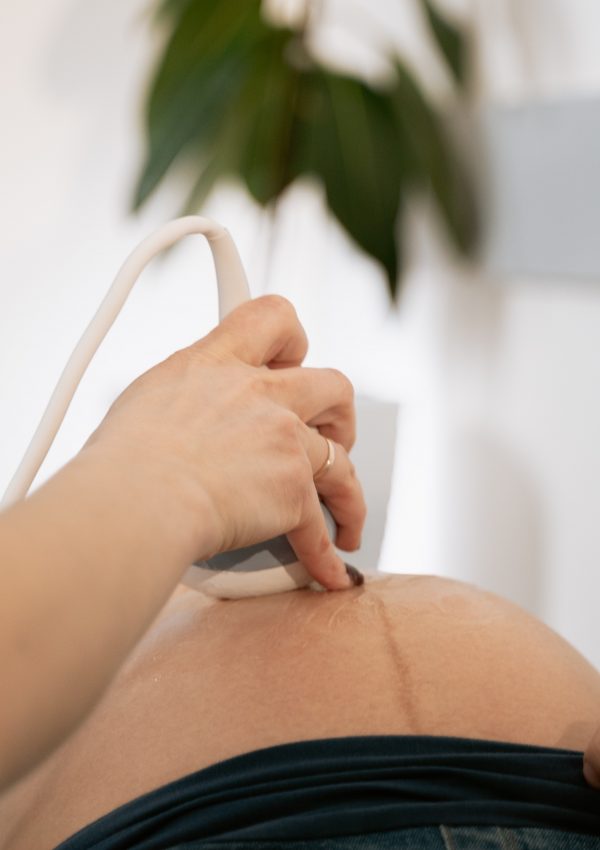Are you in your third trimester and looking for a guide on what to expect at your prenatal check-ups? Here are all the details you should know.
This post may contain affiliate links, which means I’ll receive a commission if you purchase through my links, at no extra cost to you. Please read full disclosure for more information.
Note: This guide is based off of my experience while I was pregnant. It’s meant to simply show you what to expect at prenatal check-ups and shouldn’t be taken as medical advice.
So you’re in your third trimester, the home stretch! You’re probably feeling just as tired as you were your first trimester and may even be experiencing swelling in your feet and hands. But don’t worry, the end is near.
Similarly to your second trimester, your third trimester visits will likely be quick too. You will begin to go more frequently but the same routine procedures will be done such as a weight check, blood pressure check, and a urine sample. It’s more important now than ever to continue going to your appointments!

This post is all about what to expect at your third trimester prenatal check-ups.
How long is the third trimester?
The third trimester is from week 28 through the end of week 40. To find out how far along you are, you just need to know the first day of your last period and how long your cycles tend to be. Then you can plug that info into an online calculator like this one.
You are considered full term at 39 weeks. With twins, full term is right around 37 weeks. The baby’s organs have finished developing at this time and he or she will also be at a healthy weight. Many first time pregnancies will go past the 40 weeks.
How many prenatal check-ups do you have in the third trimester?
You will have prenatal check-ups every 2 weeks from weeks 28 through 36.
Then you will have prenatal check-ups once a week from weeks 36 through 40.
Routine Procedures
The routine procedures done will be the same procedures in your first and second trimesters, with the addition of a cervix check:
Weight check
Your doctor will still want to monitor your weight throughout your third trimester. Just like the second trimester, the average weight gain is 1 pound a week, which totals about 12 pounds. In an entire pregnancy, you can expect to gain 25-35 pounds.
You can gain more or less than this amount and be entirely healthy. What matters is that your doctor gives you the OK that everything is fine. In the third trimester, conditions such as preeclampsia or gestational diabetes can develop quickly so rapid weight gain is definitely something your doctor will be paying close attention to.
Blood pressure check
Like your weight, your blood pressure will also be closely monitored throughout your third trimester.
It’s monitored because high blood pressure can be an indication of preeclampsia, just like rapid weight gain. Your caretaker will want to know about that immediately and take necessary precautions.
If you think you may have issues with high blood pressure, try drinking more water and limiting salty foods. Exercise usually helps too but you want to ask your doctor first about what types of exercises are safest. In addition, try asking about calcium and magnesium intake. Those two vitamins are known to work together to improve blood pressure.
It may also be a good idea to look into buying a blood pressure monitor so you can check your blood pressure at home. I did this and it really put me at ease even during my first trimester when I was only seeing my OB once a month.
TIP: If you don’t have a blood pressure monitor, always take note of headaches that won’t go away and dizziness. Those symptoms are typically indicators of high blood pressure.
Take a urine sample
Just like in your first and second trimesters, you will likely have to leave a urine sample at every visit. Your doctor or midwife will mostly check for excess sugar and protein at this stage.
Too much sugar in your urine could mean that you have gestational diabetes and too much protein could be an indicator of preeclampsia or bacterial infection. If your sample comes back with either of these things, you may have to do further testing.
Check the fetal heart rate
Your provider will likely use a doppler or stethoscope to check the baby’s heartbeat and make sure it’s not too fast or too slow. The average fetal heartbeat is between 110 and 160.
Measure your fundal height
Your fundal height is a measurement of how big your belly is getting using a tape measure. It’s typically not done that frequently but it could give an idea of fetal growth without doing an ultrasound.
If your belly is bigger than or smaller than it’s supposed to be then your doctor may look into further testing. In most cases, however, nothing is wrong.
Cervix check
As you near your due date, your doctor or midwife may perform a cervix check during your third trimester visits. All that happens is they check your cervix with their fingers to see how far dilated you are. This isn’t really a good indicator of how far along you are though because you could be 1cm dilated for weeks then suddenly enter active labor.
You can always decline a cervix check. Some women prefer not knowing how dilated they are because it can cause anxiety and others may prefer to know. It’s all up to you.
Topics your doctor will cover at your third trimester prenatal check-ups
Signs of preterm labor
Contractions
The contractions that you get in real labor are very different from Braxton-Hicks contractions. Braxton-Hicks contractions are ‘false labor’ contractions, which feel like your stomach getting tight and then releasing. They can go away if you drink water or switch positions. They are also irregular and don’t increase in intensity.
Real labor contractions will hurt and you may not be able to talk through them. If it’s your first pregnancy, you’ll want to download an app to time these contractions. My OB told me to go by the 5-1-1 rule, which means that you’re having contractions every 5 minutes, for an hour with every contraction lasting 1 minute. If this is the case, call your doctor right away.
Menstrual-like cramps
You may feel preterm labor cramps low in your abdomen or near your pubic bone. It varies among different women so it can be constant or irregular. It would be a good idea to call your doctor if you think you’re feeling menstrual-like cramps.
Vaginal discharge
In the beginning stages of labor, you will lose what is called a ‘mucus plug’ or ‘bloody show’. It’s basically discharge that feels a little mucusy and may have a little bit of blood. It’s more than the regular discharge and typically falls out when you go to the bathroom. This is also an indication that your cervix is becoming more dilated so definitely be on the lookout for this symptom.
Pelvic pressure
When the baby is pushing down, you may feel a pressure or heaviness in your lower abdomen, back or thighs. This is a sign of labor and you should definitely call your doctor if you’re feeling something like this.
Dull backache
It’s common to feel some sort of backache while you’re pregnant because of the weight of the baby. But the type of dull backache that signals preterm labor may be felt in your sides or even your abdomen. You can also tell whether it’s preterm labor if you switch positions and it doesn’t go away.
If something just doesn’t feel right
We typically know our bodies very well. If you ever have a sense that something isn’t right, it’s best to trust your gut and call your doctor. Best case scenario, you go for a quick visit and it was just a scare.
Signs of labor
The signs of labor are basically the same as the signs of preterm labor, except they happen at 39 weeks or later (around 37 weeks with twins).
The main things you want to look out for as you’re approaching your due date are:
- Contractions that won’t go away and increase in intensity
- Losing your mucus plug
- Your water breaking (if this happens, definitely call your doctor immediately and head to the hospital)
How to do ‘kick counts’
In your third trimester, you should be feeling your baby move pretty frequently throughout the day. As your baby gets bigger, however, you’ll feel more squirmy and slow movements instead of the kicks and punches you felt in your second trimester.
Your doctor or midwife may go over all of this with you but doing ‘kick counts’ is very simple. All you have to do is count 10 movements in 1 hour. If you don’t feel 10 movements in an hour it’s no reason to panic. Try drinking something cold or eating something sweet before trying again. If you’re then not feeling up to 10 movements in 2 hours, then call your doctor.
You should do kick counts at least once a day to ensure that everything is fine. If you forget once or twice, then it’s not a big deal. You just want want to take note of your baby’s movements and be aware if he or she is moving less than normal.
MUST KNOW: Hiccups don’t count when doing kick counts. They feel like light butterfly taps in your belly and typically resolve after a few minutes. If you feel like your baby gets the hiccups way too often, you can bring it up to your doctor. Most of the time, it’s no cause for concern.
Induction
Inducing labor is the process of starting labor using medicine or different medical techniques. It’s common for women who haven’t gone into labor naturally by 42 weeks or women who are having complications with their pregnancies. I was induced at 40 weeks exactly so I know this process well😂..
Methods of inducing labor include:
- Membrane sweep is one of the most common ways to induce labor because you can do it right at the doctor’s office. If you’ve ever had a cervix check it might feel almost exactly like that. The doctor or midwife will make a ‘sweeping motion’ around your cervix that releases hormone called prostaglandis, which starts labor. Even though this method is the easiest, it doesn’t always work.
- Breaking your water is when your doctor inserts a tool into your uterus to break your water, which is the amniotic fluid that surrounds your baby. Labor usually gets pretty intense once your water breaks so this is a good way to get the process started.
- Prostaglandis is the hormone that starts labor and can be administered orally or directly into your vagina. It’s slow acting and it works by softening your cervix and getting your body ready for labor. I was induced this way by taking the pill orally and I received one dose every 6 hours. It wasn’t until the 2nd dose where my contractions started.
- Oxytocin is another common way to induce labor. It’s a hormone that’s administered through an IV and adjusted as you progress through labor. This method can cause your contractions to be stronger and thus you usually progress faster. The downside is that is causes labor to be more painful and you’ll have to be under more supervision.
- Balloon catheter is a small balloon that is placed into your cervix to essentially force it open. It shouldn’t hurt. So if it does, make sure you let your doctor know!
Questions you should ask at your third trimester prenatal check-ups
Here are some good ideas of what to ask during your third trimester:
- How will I know when I’m in labor?
- Is it safe to get the flu shot?
- Is swelling in my hands and feet normal?
- How can I manage swelling?
- Am I supposed to feel really tired?
- What birthing classes to you recommend?
- Do I need a birth plan?
- Is there a way to pre-register at the hospital?
- What would warrant a c-section?
- What level of exercise is safest at this stage?
- Who can I bring with me to the hospital?
- Do I need a doula?
- Will you be in the hospital the whole time?
- What if I go into labor in the middle of the night?
Third Trimester Standard Tests and Procedures
Group B Strep
Group B Strep is a type of bacteria that is sometimes present in your body. It’s fairly common and isn’t usually harmful for adults but it can pose small risk for newborns. Most babies are born without a Group B Strep infection, however, it’s good practice to check for it just in case.
The way the test is administered by taking a quick swab of your vagina. You should receive the results by the time of your next visit. If you test positive, all it means is that you will be given antibiotics through an IV while you’re in labor.
Non-Stress Test
A Non-Stress Test is a noninvasive test done in order to monitor the baby’s well-being in your womb. It’s done right in the doctor’s office and usually lasts around 20-30 minutes. There are different reasons why a test like this would be done but some of the most common are carrying multiples and going past your due date.
During the test, your doctor will measure the baby’s heart rate and movement and essentially make sure that the baby isn’t under any type of stress. Usually they will have you keep track of the movements. If your doctor concludes that the baby is under stress, then you may have to do further testing.
External Cephalic Version (ECV)
If your baby is breech, you may be familiar with an ECV. A breech baby is a baby that is feet-down in your womb instead of head-down. There are different methods to turn the baby head-down but this one is one of the most common.
What the doctor does is attempt to manually turn the baby around into a headfirst or cephalic position. This procedure may put some stress on the baby so it’s common for it to be done near a delivery room in case it induces labor. The odds of this happening are rare but it’s better to be safe than sorry. It may also hurt depending on your pain threshold so it’s also common for you to be given pain medication.
If the procedure is not successful, all that means is that your baby will have to be born via a c-section.
Third Trimester Shots
Rh Shot
In one of your first trimester prenatal check-ups, you should have done a blood test called the Rh factor screening. The Rh factor is that + or – after your blood type (e.g. O+, AB-, etc.). Most people are Rh positive but if your results revealed that you’re Rh negative, there’s a chance that you and your baby may not be Rh compatible.
This may sound scary, but the treatment is very simple. You will be given a shot called RhoGAM, which contains antibodies that will prevent your immune system from reacting in response to your baby’s blood, should your baby be Rh positive. You will then be given another shot a few days before your due date to ensure that you have future safe deliveries.
Tdap (Tetanus, Diphtheria and Pertussis) Vaccine
The Tdap vaccine is recommended for pregnant women by the CDC who are at least 27 weeks along. It’s also recommended for your partner too. Your doctor should go over all of the details with you but the vaccine protects against these 3 infections:
- Tetanus can weaken the muscles that help you breathe and can be life-threatnening.
- Diphtheria can restrict breathing.
- Pertussis is Whooping Cough, which can be deadly for babies.
The Tdap vaccine is not mandatory. It’s simply recommended because of the protection against whooping cough. When your family and friends come to visit your little one they may not realize they’re a carrier and the baby doesn’t get the vaccine until he or she is 2 months. When you get it, you can give antibodies through the umbilical cord.
Ultrasounds
Growth Scan
A growth scan is an ultrasound that quickly checks to see how your baby is growing. It’s nowhere near as in depth as the Level 2 Ultrasound you get in your second trimester and will feel more or less like the ultrasound you received in your first trimester.
The ultrasound tech will measure the baby’s length, as well as head circumference and arm and leg length. They will also check to make sure the baby is head-down and measure the volume of amniotic fluid that surrounds the baby. You may have one or more growth scan in your third trimester, especially if you’re carrying multiples.
Was this ultimate guide to your third trimester prenatal check-ups helpful? Let me know in the comments!
RELATED POST: What To Expect At Your First Trimester Prenatal Check-Ups
This post was all about what to expect at your first trimester prenatal check-ups.




